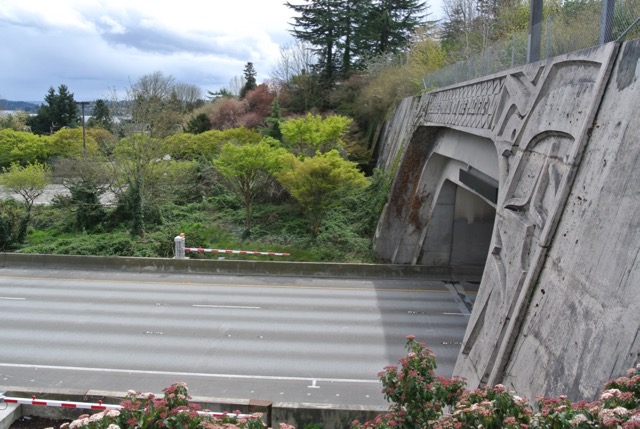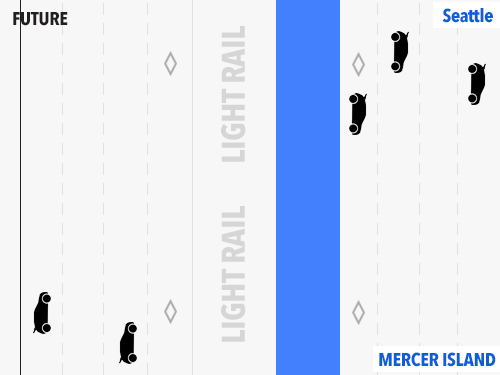
Interstate 90 runs just more than 3,000 miles from Boston to Washington state, but it’s the relatively tiny 10-mile stretch connecting Bellevue to Seattle that impacts local commuters.
Commuter complaints about traffic on I-90 peaked during the last two years as Washington State Department of Transportation (WSDOT) did construction to move high occupancy vehicle lanes to make room for Sound Transit’s Link Light Rail project in 2023.
When Sound Transit approached the state to take over the middle HOV lanes for their East Link Light Rail project, WSDOT agreed to give them the I-90 express lanes once they had completed upgrades to the tunnels.
In the last two years on the I-90 Two-Way Transit and HOV Operations project, WSDOT has upgraded lighting, emergency telephones, and emergency signs. They’ve upgraded the motors on air circulation fans in the interstate’s tunnels, added virtual message signs, and added lights along the floor of the tunnels, said WSDOT Transportation Electrical Engineer Efkar Arslan.
Some upgrades to tunnel safety are state of the art.
New CO2 sensors along with more powerful fans will propel smoke out of the tunnel and bring fresh oxygen in when there is a problem.
“When a fire happens, infrared cameras detect it and that system then sprays a water and foam substance only to that zone so a mess isn’t created throughout,” said Arslan.

Commuters are noticing signs on I-90 that restrict flammable cargo in the tunnels.
WSDOT Public Information Officer Annie Johnson says that upgrading these safety systems requires some parts of the system to be offline while construction is happening. WSDOT created the restriction so that when they turn off the system there’s no danger of flammable materials being in the tunnels without an active emergency system.
How much gas or flammable material is too much?
The Washington State Patrol is responsible for setting the flammable restriction limit on how much gas is allowed to pass through the tunnel.
“The restriction is intended for gas and propane tanker trucks that carry flammable fuel,” said Rick Johnson, Public Information Officer for WSP. “It is not speaking of the gas that powers your vehicle.”
When the I-90 bridge was first built, most of the jobs in King County were located in Seattle. Those who lived in Bellevue would make the commute across the lake. That is why the express lanes are open Westbound in the mornings and eastbound in the evenings, said Annie Johnson.
“When I-90 was built in the late ‘80s the region was a very different place so express lanes made sense,” said Annie Johnson.
As Bellevue has grown, people now commute the opposite way and can’t benefit from these express lanes. The new construction will allow HOV traffic in both directions, all day.
“Right now, the HOV lanes start in Bellevue and run to the middle of Mercer Island. The project will extend it across the floating bridge to end around Rainier Avenue,” said Annie Johnson.
The nearly $283 million I-90 construction project is funded by a few different sources. Sound Transit provides the bulk of it — just under $240 million.
In June 2017, however, the I-90 middle express lanes will be owned and operated by Sound Transit.
“Great thing is, traffic won’t be affected because they will just be working in the middle lanes and there will be an added HOV lane to both east and westbound sides,” said Arslan.

Sound Transit will work on making room for the East Link Light Rail that will connect the 14-mile stretch in between Seattle and Redmond.
The I-90 bridge has two tunnels along this stretch: the Mercer Island and the Mount Baker Ridge tunnel. These are the two original 1940 tunnels carrying eastbound traffic. The newer tunnels, added in 1989, carry express and westbound traffic.
Over the next few months, WSDOT will work on polishing up the work they have done by painting, cleaning, and running more tests. This will cause more closures and delays until the completion in June.
“The tunnels won’t open to tankers,” says Arslan, “‘til we’re sure 100 percent the tunnel can handle it.”
Newroz Saribas is a senior attending the University of Washington and an aspiring journalist. She was born and raised in Bellevue and like a true northwestern she loves to hike.



